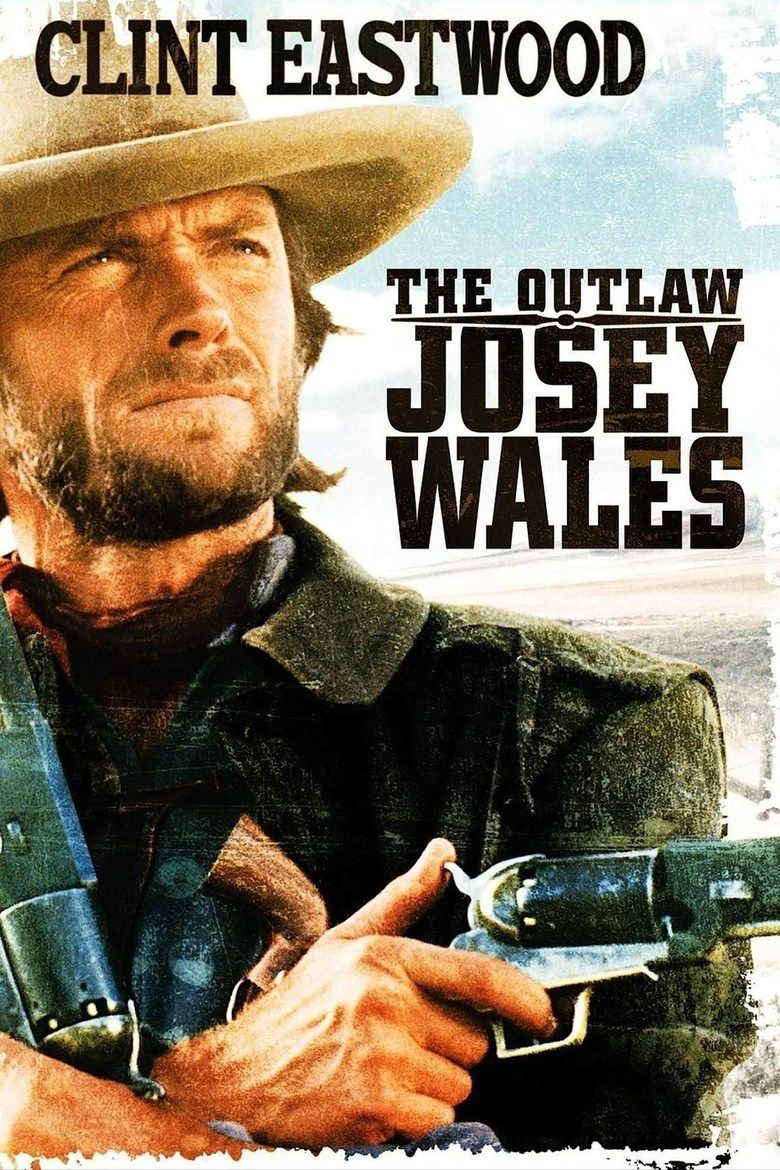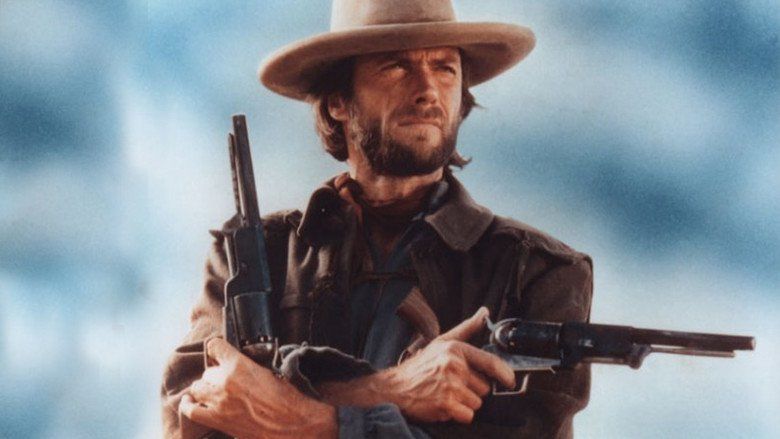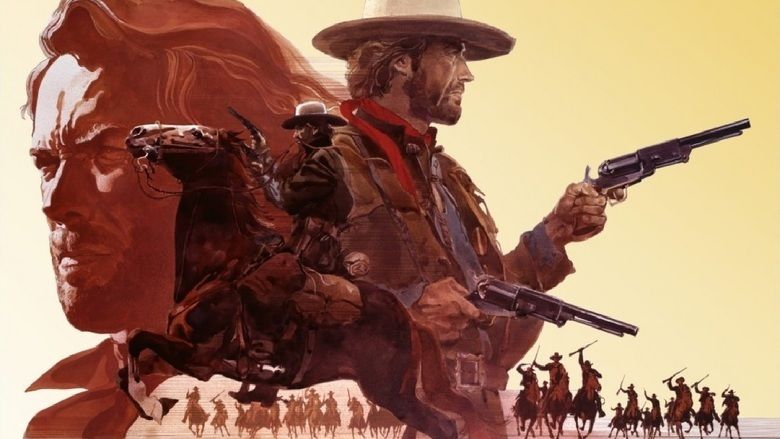The Outlaw Josey Wales
8.2 /10 1 Votes
94% Rotten Tomatoes Duration Language English | 7.9/10 IMDb 3/4 Roger Ebert Genre Western Country United States | |||||||||||||||||||||||||||||||||
 | ||||||||||||||||||||||||||||||||||
Release date June 30, 1976 (1976-06-30) Based on Gone to Texas1973 novel by Forrest Carter Cast (Josey Wales), (Lone Watie), (Laura Lee), (Terrill), (Fletcher), (Grandma Sarah) Similar movies Back to the Future Part III , Dances with Wolves , , Bonnie and Clyde , Lone Wolf McQuade , Pale Rider Tagline ...an army of one. | ||||||||||||||||||||||||||||||||||
The outlaw josey wales 1976 official trailer clint eastwood western movie hd
The Outlaw Josey Wales is a 1976 American revisionist Western DeLuxe Color and Panavision film set during and after the American Civil War. It was directed by and starred Clint Eastwood (as the eponymous Josey Wales), with Chief Dan George, Sondra Locke, Sam Bottoms, and Geraldine Keams. The film tells the story of Josey Wales, a Missouri farmer whose family is murdered by Union militants during the Civil War. Driven to revenge, Wales joins a Confederate guerrilla band and fights in the Civil War. After the war, all the fighters in Wales' group except for Wales surrender to Union officers, but they end up being massacred. Wales becomes an outlaw and is pursued by bounty hunters and Union soldiers.
Contents
- The outlaw josey wales 1976 official trailer clint eastwood western movie hd
- Best scene from the outlaw josey wales
- Plot
- Production
- Reception
- Awards
- Meaning
- References

The film was adapted by Sonia Chernus and Philip Kaufman from author Forrest Carter's 1972 novel The Rebel Outlaw: Josey Wales (republished, as shown in the movie's opening credits, as Gone to Texas). The film was a commercial success, earning $31.8 million against a $3.7 million budget. In 1996, the film was selected for preservation in the National Film Registry of the Library of Congress for being deemed "culturally, historically, or aesthetically significant".

Josey Wales was portrayed by Michael Parks in the film's 1986 sequel, The Return of Josey Wales.

Best scene from the outlaw josey wales
Plot

Josey Wales, a Missouri farmer, is driven to revenge by the murder of his wife and young son by a band of pro-Union Jayhawker militants. The murderers were from Senator James H. Lane's Kansas Brigade, led by Captain Terrill.

After grieving and burying his wife and son, Wales joins a group of pro-Confederate Missouri Bushwhackers led by William T. Anderson and fights in the Civil War. At the conclusion of the war, Captain Fletcher persuades the guerrillas to surrender, saying they have been granted amnesty. Wales refuses to surrender. As a result, he and one young man are the only survivors when Captain Terrill's Redlegs massacre the surrendering men. Wales intervenes and guns down several Redlegs with a Gatling gun.

Senator Lane forces Fletcher to work with Terrill in tracking down Wales and puts a $5,000 bounty on Wales, who is now on the run from Union militia and bounty hunters. Along the way, despite wishing to be left alone, he accumulates a diverse group of companions. They include an old Cherokee named Lone Watie, a young Navajo woman, and an elderly woman from Kansas and her granddaughter Laura Lee, whom Wales rescues from Comancheros. At Santo Rio, two men, Travis and Chato, join their group.
Wales and his companions find the abandoned ranch owned by Laura's father and inhabit it after Wales parleys and makes peace with the neighboring Comanche tribe leader, Ten Bears. Meanwhile, a bounty hunter who identified Wales at Santo Rio, guides Captain Terrill and his men to the town. The following morning, the ranch is attacked by the Redlegs. Wales' companions take shelter in the fortified ranch house and open fire, gunning down all of Terrill's men. A wounded Wales, despite being out of ammunition, pursues the fleeing Terrill. When he corners him, Wales dry fires his four pistols through all the empty chambers before stabbing and killing Terrill with his own cavalry sword.
At the bar in Santa Rio, Wales finds Fletcher with two Texas Rangers. The locals at the bar, who refer to Wales as "Mr. Wilson," tell the Rangers that Wales was killed in a shoot-out in Monterrey, Mexico. The Rangers accept this story and move on. Fletcher refuses to believe the story, but pretends to not recognize Wales and says that he will go to Mexico to look for Wales himself, and try to convince him that the war is over, because he owes him that. Wales says that they all died a little in the war, before riding off.
Production
The Outlaw Josey Wales was inspired by a 1972 novel by Forrest Carter, and was originally titled The Rebel Outlaw: Josey Wales and later retitled Gone to Texas. The script was worked on by Sonia Chernus and producer Bob Daley at Malpaso, and Eastwood himself paid some of the money to obtain the screen rights. Michael Cimino and Philip Kaufman later oversaw the writing of the script, aiding Chernus. Kaufman wanted the film to stay as close to the novel as possible in style and retained many of the mannerisms in Wales's character which Eastwood would display on screen, such as his distinctive lingo with words like "reckon", "hoss" (instead of "horse"), and "ye" (instead of "you") and spitting tobacco juice on animals and victims. The characters of Wales, the Cherokee chief, Navajo woman, and the old settler woman and her daughter all appeared in the novel. Contrariwise, Kaufman was less happy with the novel's political stance; he felt that it had been "written by a crude fascist" and that "the man's hatred of government was insane". He also felt that that element of the script needed to be severely toned down, but, he later said, "Clint didn't, and it was his film". Kaufman was later fired by Eastwood, who took over the film's direction himself.
Cinematographer Bruce Surtees, James Fargo, and Fritz Manes scouted for locations and eventually found sites in Utah, Arizona, Wyoming, and Oroville, California even before they saw the final script. Kaufman cast Chief Dan George, who had been nominated for an Academy Award for Supporting Actor in Little Big Man, as the old Cherokee Lone Watie. Sondra Locke, also a previous Academy Award nominee, was cast by Eastwood against Kaufman's wishes as the granddaughter of the old settler woman, Laura Lee. This marked the beginning of a close relationship between Eastwood and Locke that would last six films and the beginning of a romance that would last into the late 1980s. The film also featured his real-life seven-year-old son Kyle Eastwood, with Ferris Webster hired as editor and Jerry Fielding as composer.
Principal photography began in mid-October 1975 in Lake Powell. A rift between Eastwood and Kaufman developed during the filming. Kaufman insisted on filming with a meticulous attention to detail, which caused disagreements with Eastwood, not to mention the attraction the two shared towards Locke and apparent jealousy on Kaufman's part in regards to their emerging relationship. One evening, Kaufman insisted on finding a beer can as a prop to be used in a scene, but while he was absent, Eastwood ordered Surtees to quickly shoot the scene as light was fading and then drove away, leaving before Kaufman had returned. Soon after, filming moved to Kanab, Utah. On October 24, 1975, Kaufman was fired at Eastwood's command by producer Bob Daley. The sacking caused an outrage amongst the Directors Guild of America and other important Hollywood executives, since the director had already worked hard on the film, including completing all of the pre-production. Pressure mounted on Warner Bros. and Eastwood to back down, but their refusal to do so resulted in a fine, reported to be around $60,000 for the violation. This resulted in the Director's Guild passing new legislation, known as 'the Eastwood Rule', which prohibits an actor or producer from firing the director and then becoming the director himself. From then on, the film was directed by Eastwood himself with Daley second-in-command, but with Kaufman's planning already in place, the team were able to finish making the film efficiently.
Reception
Upon release in August 1976, The Outlaw Josey Wales was widely acclaimed by critics, many of whom saw Eastwood's role as an iconic one, relating it with much of America's ancestral past and the destiny of the nation after the American Civil War. The film was pre-screened at the Sun Valley Center for the Arts and Humanities in Idaho in a six-day conference entitled Western Movies: Myths and Images. Academics such as Bruce Jackson, critics such as Jay Cocks and Arthur Knight and directors such as King Vidor, Henry King, William Wyler and Howard Hawks were invited to the screening. The film would later appear in Time magazine's Top 10 films of the year. Roger Ebert compared the nature and vulnerability of Eastwood's portrayal of Josey Wales with his "Man with No Name" character in the Dollars Trilogy and praised the atmosphere of the film. On The Merv Griffin Show, Orson Welles lauded the film, calling Eastwood "one of America's finest directors."
Review aggregator Rotten Tomatoes retrospectively gave the film a 95% rating based on reviews from 38 critics.
Awards
The Outlaw Josey Wales was nominated for the Academy Award for Original Music Score. In 1996, it was deemed "culturally, historically, or aesthetically significant" by the United States Library of Congress and selected for preservation in the National Film Registry. It was also one of the few Western films to receive critical and commercial success in the 1970s at a time when the Western was thought to be dying as a major genre in Hollywood.
Clint Eastwood says on the 1999 DVD release that the movie is "certainly one of the high points of my career... in the Western genre of filmmaking."
Meaning
Eastwood has called The Outlaw Josey Wales an anti-war film. In an interview with The Wall Street Journal, he said:
As for Josey Wales, I saw the parallels to the modern day at that time. Everybody gets tired of it, but it never ends. A war is a horrible thing, but it's also a unifier of countries... Man becomes his most creative during war. Look at the amount of weaponry that was made in four short years of World War II—the amount of ships and guns and tanks and inventions and planes and P-38s and P-51s, and just the urgency and the camaraderie, and the unifying. But that's kind of a sad statement on mankind, if that's what it takes.
References
The Outlaw Josey Wales WikipediaThe Outlaw Josey Wales IMDbThe Outlaw Josey Wales Rotten TomatoesThe Outlaw Josey Wales Roger EbertThe Outlaw Josey Wales themoviedb.org
